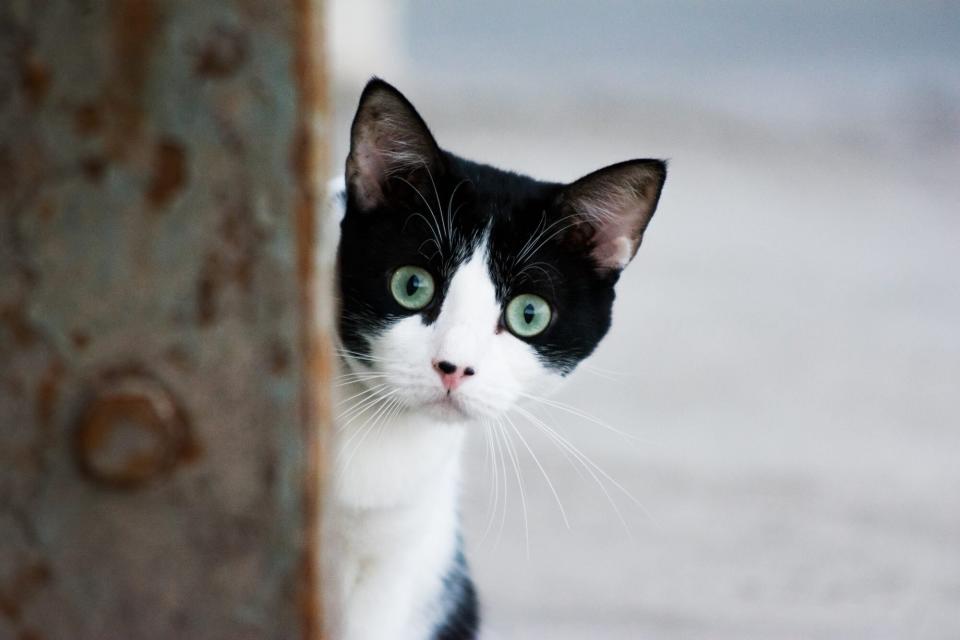When Do Kittens' Eyes Change Color?

Felix Roser / EyeEm / Getty
TABLE OF CONTENTS
On This Page
Kitten Eyes Change As They Grow
Predicting Kitten Eye Colors
How to Tell a Kitten's Age Based on Their Eyes
Worrisome Cat Eye Colors
When you have a litter of kittens, you can't help but be amazed by all the changes they experience in such a short amount of time. At first, they only seem to nurse and nap, and peer at you with a hazy gaze. Then before you know it, they're doing backflips off the cat tree all wild-eyed! So between these levels of accomplishment, when do kittens' eyes change color—and why?
Kitten Eyes Change As They Grow
Rowyn C. Rose is a science communications specialist at Basepaws, a cat DNA test brand. She tells Daily Paws that cats' eyes have a pigment of specialized cells called melanocytes found in the iris (the colored part of the eye). The front layer of the iris, known as the stroma, absorbs longer wavelengths and reflects shorter ones, based on the amount of melanocytes.
This is why most adult cats have more diverse eye colors: There are more melanocytes in the pigment. But not when they're born. "An overwhelming majority [of kittens] have blue eyes because pigment doesn't begin to accumulate in the iris until the first few weeks of life," Rose says.
Tarina L. Anthony, DVM, is a longtime practitioner of feline-exclusive medicine, and owner and medical director of Aurora Cat Hospital and Hotel in Aurora, Colo. She says that kittens' eyes open when they're about 7–10 days old, but "anywhere between two and 16 days has been reported." This is also your first opportunity to confirm eye health. Anthony advises making sure kittens' eyes are free of discharge, as upper respiratory infections are common in newborns with naive immune systems. Their eyes might be mostly closed but shouldn't be "gooed shut."
Kittens' eyes change color when they're about 4–8 weeks old. Rose says this is when melanocytes migrate to the iris and produce melanin. However, some kitties, depending on breed, retain their baby blues. More on that below.
Predicting Kitten Eye Colors
Can you do it? Anthony says not likely, unless you've confirmed the heritage of the tom (Dad Cat) and queen (Mom Cat) 100 percent.
"It's hard to know what the eye color will be based on any markings on the kittens themselves," she adds. "Of course, some breeds tend to have certain eye colors." Which ones might these be?
Some cats continue to have low levels of melanocytes into adulthood and keep their blue eyes. These include Balinese, Birman, colorpoint shorthair, Himalayan, ragdoll, Tonkinese, Siamese, and snowshoe breeds.
Although amber-colored eyes are fairly common, dark copper eyes are rather rare. Usually they're a status symbol of the Chartreux breed, and sometimes the Bombay, too.
Kitties sporting odd-colored eyes—usually one blue and the other on a spectrum of green, yellow, or brown—have a condition called heterochromia, which is often genetic. Breeds such as Khao Manee and Turkish van frequently have these jewel-toned eyes.
Strictly green eyes in cats complete the appearance of a few adults, including Egyptian maus and Russian blues.
RELATED: Why Do Cats' Eyes Glow in the Dark?
How to Tell a Kitten's Age Based on Their Eyes
Anthony says veterinary professionals don't use kittens' eyes changing color as an indicator of age. They're more likely to use "juvenile dentition—the eruption of baby teeth" as the go-to for age approximation.
Kitten milk teeth start out as tooth buds, then blossom into sharp little nippers within three to six weeks. Fortunately for a nursing mom cat, six weeks is around the time kittens start eating food, too! Then, between the ages of 3–6 months, their milk teeth fall out, and they'll have permanent adult teeth.
Worrisome Cat Eye Colors
Even if you're not sure what breed your kitten is, pay close attention for health issues whose symptoms include changes in their eyes.
For example, Anthony says liver disease is a concern—specifically portosystemic shunt, a congenital condition when blood doesn't reach the liver properly and toxins build up in the blood. "There's some evidence that cats with [this condition] can have copper-colored irises," she adds. "While there are cats with copper-colored eyes that don't have this condition, and cats with this condition that don't have this eye color, any kitten that shows this eye color along with other clinical signs such as low body weight, decreased mentation (appearing dull), lethargy, and seizures should be evaluated for a liver shunt."
Other common eye problems for cats don't affect the iris directly to change its color, but their gaze might appear cloudy, or there could be discoloration surrounding the iris. Be on the lookout for conditions such as:
Blepharitis, or eyelid inflammation, which appears red and irritated
Conjunctivitis or "pink eye," a form of eye infection with many causes
Glaucoma, which causes cloudy vision, redness, and swollen eyes
Cataracts, a condition more common with senior cats, impairs vision
Your kitty's annual veterinary checkup visit includes an eye exam, but don't hesitate to book an appointment right away if you spot any signs of eye trouble.

